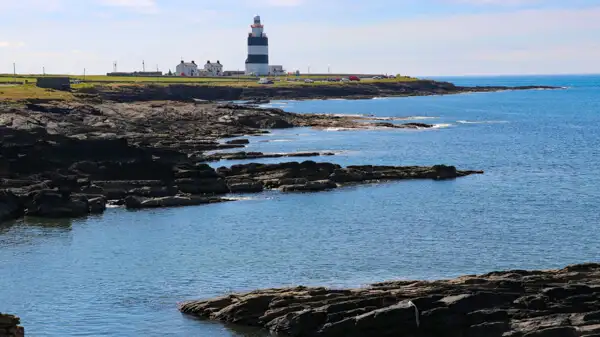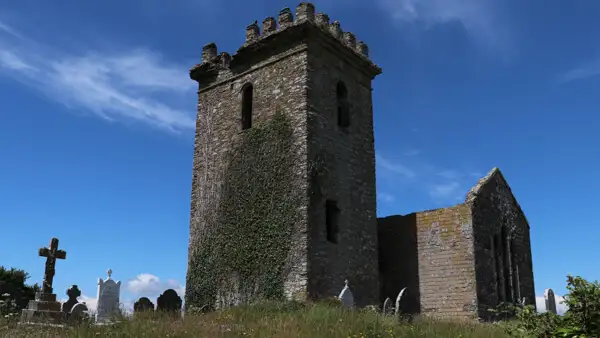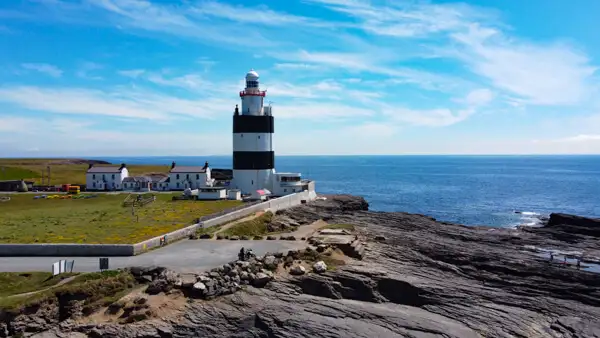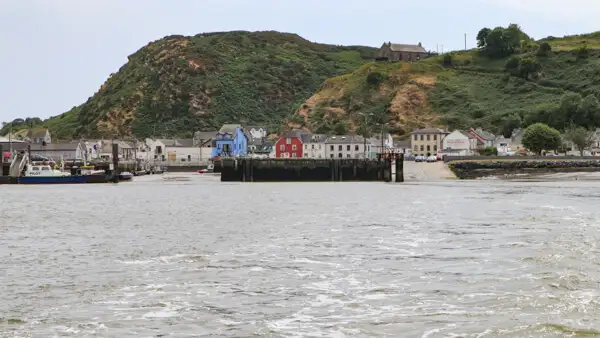No, the title is no exaggeration: here, on the south-east coast of Ireland, a massive lighthouse has been defying the stormy Irish sea – for more than 800 years!
Page Contents (click line to jump the text)

History of the Hook Lighthouse
St Dubhán and his beacon
We are in the 5th century. We don’t know exactly when. But we do know where we are: The narrow spit of land is called Rinn Dubháin, which means the land of Dubhán.
Dubhán is a monk. He actually comes from Wales, but now lives here on this flat, rocky headland at the mouth of the Three Sisters. He has built a small wooden church here.
The Three Sisters are the rivers Nore, Barrow and Suir, which join just outside Waterford and flow into the sea here with great force.
Waterford is still a small settlement. The Vikings will not found Ireland’s first town here for another 400 years.
But there is already shipping traffic. Fishermen earn their hard-earned income from the stormy waters and occasionally merchant ships sail along the coast or into the estuary.
Too many ships already lie at the bottom of the sea. In the storm they run aground on the cliffs.
Tonight is another stormy night. Dubhán goes to the headland and lights the fire. He has built a beacon here, a wooden tower to warn sailors of the cliffs. On nights like this, he will spend the whole night there and keep his fire going so that the ships can see that danger is imminent.
He has no idea that the headland will also bear his name in the future: Dubhán means hook or headland in English and Hook Peninsula is therefore roughly the English version of Rinn Dubháin. Today it is St Dubhán and the wooden church later became a stone church.

The knight William Marshal and his lighthouse
Let’s fast-forward a bit in time to the thirteenth century. The Anglo-Normans rule over large parts of Ireland. The Norman knight William Marshal, Earl of Pembroke, reigns in Kilkenny. He built a massive castle there, today’s Kilkenny Castle, and in his time Kilkenny was granted town charter. His estates extend far across the south of what is now County Wexford.
He brings his master builders to the top of the Hook Peninsula. They are to replace the wooden beacon with a massive lighthouse. The builders know how to build towers, as they build them for the country’s castles anyway.
But this tower is different, because it is planned as a lighthouse from the outset. Construction begins around the year 1210. 20 years later, the lighthouse is fully completed.
The walls are several metres thick at their base and the tower has a long spiral staircase and three floors inside. There is also a room for coal and wood, the fuel used to operate the lighthouse.

Today’s Hook Lighthouse
Much later, a steel tower with an automated beacon was built on top of the medieval stone tower. Today the tower is 35 metres high and still 12 metres wide in diameter.
Hook Lighthouse is now one of the oldest lighthouses in the world and is in fact the oldest – still actively functioning – lighthouse in the world!
The lighthouse keepers’ houses are now mainly open to visitors: There is a small café, you can take a guided tour and there is a small exhibition about the sea and life on and in the sea.
Access to the grounds is completely free and in summer you will see many families with children playing and picnicking on the large lawn in front of the lighthouse.
Even if you’re not that interested in the history, the lighthouse is simply beautiful and the location on the cliffs is marvellous. The drive up to the peninsula already gives you that holiday feeling. You can take a wonderful walk around the lighthouse and look across the wide bay and estuary to County Waterford on the other side. You can find more information about Hook Lighthouse here: https://hookheritage.ie/.
The Hook Peninsula
The Hook Peninsula is a very rural headland. There are a few small fishing harbours and small villages and a few holiday homes. But in general, tourism here is very manageable and life is rather cosy. There are a few other attractions in the surrounding area:
Kennedy’s Homestead
The family of American President J.F. Kennedy originally came from this region. The family home is now a small museum that you can visit. See: https://www.kennedyhomestead.ie/.
Tintern Abbey
Tintern Abbey is the well-preserved ruin of a large Cistercian abbey from the 13th century, which was also founded by the knight William Marshal. See: https://heritageireland.ie/places-to-visit/tintern-abbey/.

Fethard
Fethard is a small town with accommodation, food and drink, a ruined castle (Fethard Castle) and a small fishing harbour (Fethard-on-Sea Harbour).
Dollar Bay and Booley Beach
These two beautiful beaches can be found on the west coast of the Peninsula, on the way to Duncannon.
Duncannon Fort
This bastion is around 450 years old. It guarded the entrance to the estuary with cannons. Today you can visit it, see: https://duncannonfort.ie/.
If you are planning on travelling on to Waterford, I can highly recommend the small ferry from Ballyhack to Passage East. The short crossing is really nice.
Conclusion
Hook Lighthouse is one of the better-known sights in County Wexford. I would still describe it as a “hidden gem”, because not many people come here.
I know the Hook Peninsula very well myself, as I’ve been here several times, mostly by motorbike, but also by car.
We live in the south-east (second home) – originally we are from Germany.
Many of our motorbike guests have recommended the Hook Lighthouse as an excursion destination and everyone has enjoyed it so far. I’m sure you’ll love it too!
Have fun at Hook Lighthouse!
More interesting articles for you
WATERFORD AND THE VIKINGS
THE AMAZING KILKENNY CASTLE
THE REBELLIOUS TOWN OF ENNISCORTHY
WEXFORD – SO OLD – SO NEW!
Picture credits cover picture: Hook Head Lighthouse and the old lightkeeper`s houses, photo by Ulrich Knüppel-Gertberg (www.irland-insider.de, www.ireland-insider.com)